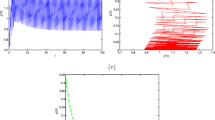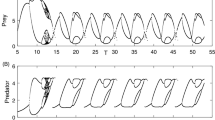Abstract
A model for the sterile insect release method of pest control in which the target species is under predatory or parasitic regulation is analyzed. The equations are nondimensionalized and the rescaled parameters are interpreted. There are four types of equilibria, whose existence and stability depend on which of ten regions of parameter space contain the rescaled parameters, and in turn give minimal release rates to achieve eradication of the pest. In at least one region, Hopf bifurcation theory shows the existence of limit cycles, but they are found to be unstable. In addition, the optimal release rate to minimize a total cost functional for pest control by the sterile release method is studied. Both approaches show that when predation accounts for a large fraction of the natural deaths, the necessary release rate and total cost are higher than for weak predation. If the predators are removed without being replaced by any other source of mortality, the cost rises in all cases but rises much more dramatically for cases with strong predation. A definite danger of the sterile release method when some predatory control exists is that the predators are frequently driven extinct before the prey, so that the target species could explode to much higher levels and be more difficult to eradicate again after the sterile release is terminated.
Similar content being viewed by others
References
Askew, R. R.: Parasitic insects. New York: American Elsevier Pub. Co. 1971
Barclay, H. J.: The sterile release method for population control with interspecific competition. Res. Pop. Ecol. 23, 145–155 (1981)
Barclay, H. J., Mackauer, M.: The sterile insect release method for pest control: A density dependent model. Envir. Entom. 9, 810–817 (1980a)
Barclay, H. J., Mackauer, M.: Effects of sterile insect releases on a population under predation or parasitism. Res. Pop. Ecol. 22, 136–146 (1980b)
Berkovitz, L. D.: Optimal control theory. Berlin-Heidelberg-New York: Springer 1974
Bryson, A., Ho, Y. C.: Applied optimal control. Waltham, MA: Blaisdell 1969
Clark, C. W.: Mathematical bioeconomics: The optimal management of renewable resources. New York: Wiley 1976
De Bach, P.: Biological control by natural enemies. London: Cambridge Univ. Press 1974
Hassard, B. D., Kazarinoff, N. D., Wan, Y-H.: Theory and applications of Hopf bifurcation. London Math. Soc. Lecture Note Series, Vol. 41. Cambridge: Cambridge Univ. Press 1981
Huffaker, C. B., Messenger, P. S., De Bach, P.: The natural enemy component in natural control and the theory of biological control. In: Biological control. Huffaker, C. B. (ed.). New York: Plenum Press 1971
Ito, Y., Kawamoto, K.: Number of generations necessary to attain eradication of an insect pest with sterile insect release method: A model study. Res. Pop. Ecol. 29, 216–226 (1979)
Lanham, U.: The insects. New York: Columbia Univ. Press 1967
Marsden, J. E., McCracken, M.: The Hopf bifurcation and its applications. Applied Math. Sc., Vol. 19. Berlin-Heidelberg-New York: Springer 1976
Mautner Markhof, F. (ed.): Computer models and application of the sterile male technique. Panel Proceedings, IAEA, Vienna, 1973
Proverbs, M. D.: Ecology and sterile release programs, the measurement of relevant population processes before and during release and the assessment of results. In: The use of genetics in insect control. Pal, R., Whitten, M. J. (eds.). Amsterdam: Elsevier 1974
Author information
Authors and Affiliations
Rights and permissions
About this article
Cite this article
Harrison, G.W., Barclay, H.J. & van den Driessche, P. Analysis of a sterile insect release model with predation. J. Math. Biology 16, 33–48 (1982). https://doi.org/10.1007/BF00275159
Revised:
Issue Date:
DOI: https://doi.org/10.1007/BF00275159




